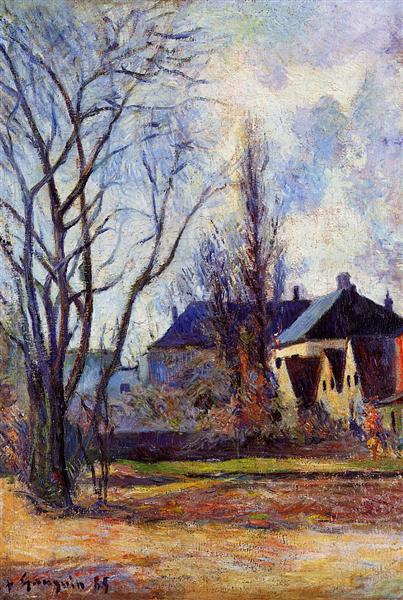Beschreibung
In The End of Winter (1885), Paul Gauguin offers us an evocative depiction of the end of a season and the rebirth of life. This work is a clear example of the innovative approach that Gauguin took in his search for emotional expression through color and form. The painting, with its palette of predominantly warm and earthy tones, suggests an atmosphere of transformation and hope, capturing the essence of the transition from the cold of winter to the warmth of spring.
At first glance, the painting is characterized by a landscape unfolding before us, where the mood of melancholy is interrupted by the vital promise of what is to come. The sky, with its mix of blues and greys, suggests the retreat of the cold winter clouds, while the illuminated areas painted in orange and yellow tones evoke the increasingly present light of the sun. Gauguin, known for his interest in the symbolism of color, uses these nuances not only as a representation of the time of day, but also as a statement of the emotional change that accompanies the end of a season.
The composition focuses on the fusion of natural elements and the presence of the human being, often absent or secondary in the creations of his contemporaries. In this work, the human figure becomes symbolic of the rebirth that the arrival of spring implies. On the left of the painting, we see a woman who, almost fused with the landscape, seems to be part of the environment, thus representing the intimate connection between humanity and nature. Her clothing blends into the palette of the painting, with tones that reflect the earth and vegetation around her, and her posture suggests that she is in a moment of contemplation, a reflection on the cycle of life and the renewal that is approaching.
Gauguin painted The End of Winter at a time when his style had already evolved significantly. Coming from an impressionist tradition, he began to explore more symbolic themes, a characteristic that would be consolidated in his later work. This work captures Gauguin's interest in deeper and more subjective experiences, distancing himself from the strict realism that dominated the art of his time, to enter a universe where emotion and sensory representation prevail.
The use of lines and shapes in “The End of Winter” also reflects Gauguin’s search for a pictorial structure that breaks with tradition. The shapes in the landscape are more schematic than detailed, allowing the viewer to interpret the work not only through the visual, but also on an emotional level. This choice of a simplified approach aligns with the notion that art should communicate universal experiences rather than merely be a representation of tangible reality.
In the work, the intentional use of colour, shape and the human figure encapsulates the idea of the end of a cycle, not only in the context of the climate, but also in a broader sense of the human experience. “The End of Winter” thus becomes a celebration of life and continuity, showing that, despite how bleak winter may seem, spring, with all its promise, will always come. Gauguin’s work, in its simple and vibrant complexity, invites the viewer to reflect on the mutable nature of life, a theme that resonates deeply in the artistic context of the 19th century and remains relevant today.
KUADROS ©, a famous painting on your wall.
Hand-made oil painting reproductions, with the quality of professional artists and the distinctive seal of KUADROS ©.
Painting reproduction service with satisfaction guarantee. If you are not completely satisfied with the replica of your painting, we will refund 100% of your money.

